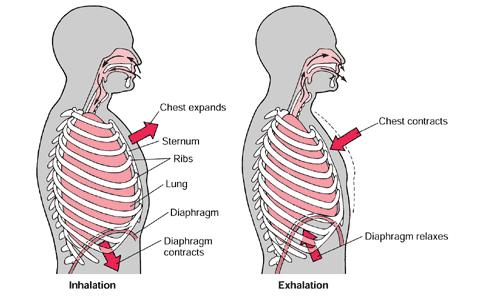WherZat Music
Introduction
It is not easy to explain the breathing process for wind instrumentalists. You will need to read through the pages slowly and ask heaps of questions when you don't understand. Try each of the activities and show your tutor who will check its accuracy. The techniques explained will certainly allow you to play your instrument much better. Likewise the process can be used in other activities such as relaxation and controlled breathing when anxiety attacks occur.
Breathing for Wind Instruments
Breathing for the woodwind and brass player is different from normal breathing. We normally breath with a shallow relaxed breath (upper chest breath) with the inhale and exhale cycle reasonable evenly spaced. When we breath in this way we only fill our lungs to about 20% of its capacity. It is only when we exercise that the breath becomes deeper and faster as the demand for oxygen increases. Neither technique is good for wind players.
When breathing while playing a wind instrument (brass our woodwind) it requires a quick deep inhalation with a monitored (controlled) exhale that could last as long as 30 seconds. Controlled breathing in this way provides support for the pitch, dynamics and tonal quality. The method of breathing is called "Diaphragmatic Breathing" which is also taught to trained singers.
One of the worlds most amazing Jazz trumpeters is Australian, James Morrison.
 Click on the link below and hear him talk on breathing for the trumpet. Its contents and reasoning is equally valuable for all wind instrumentalists.
Click on the link below and hear him talk on breathing for the trumpet. Its contents and reasoning is equally valuable for all wind instrumentalists.
Whilst he does not expand on the actual breathing process the relaxed inhale and the focused exhale is most important.
Activity: While you are on Youtube select a video of James playing and you will see how he uses his air to perform. You will also notice he is a multi-instrumentalist and is equally at home on the trombone, piano and woodwind instruments.
Activity: Listen to this video several times and practice the exercises explained by Mr Morrison
The Breathing Process
There is a number of names given to this type of breathing - Diaphragmatic Breathing, Abdominal Breathing and even Belly Breathing. They all correct and their outcome is the same. Listen to this video from Sesame Street with Common and Colbie Caillat presenting "Belly Breathe" with Elmo. Like James Morrison this video does not explain what happens inside your body but you can clearly see by the children placing their hands over their tummy that it pushes out when the air is inhaled.
Activity: Try belly breathing yourself exactly as it is shown on the video. Practice the process as many times as you can so it becomes natural.
Your Respiratory System
It is not the intension of this text to fully explain the Human Respiratory System. Our aim is to simple show how the lungs expand and contract and what effect the supporting muscles both in the chest cavity and the diaphragm have on the process.
Firstly think of the lungs being like a balloon.

|

|
|
Without air inside it is flat
|
As you blow it up it increases in size expanding in all directions making a ball shape.
The more air the bigger the size.
|
Yes your lungs expand when you inhale and they grow outward in all directions to fill with air. The only difference is we have the rib cage and the lower muscle call the diaphragm to limit the amount of air we can take in. This is why we ask you not to lean on the back of your chair when playing. This can hinder the expansion of the lungs across your back reducing the amount of air you inhale.
I agree with the belly technique for breathing and it is essential step for wind instrument players. However it does not go far enough for the musician. Looking at the balloon example it is clear the balloon increases in size in all directions as more air is introduced. As musicians we need to understand there is a staged process to inhale air to fully fill our lungs like the balloon.
The stages of inhalation divides the upper torso into these areas:
1. Lower lungs expand by belly breathing with the use of the diaphragm's muscles. The lower part of the rib cage begins to expand as the lower lungs fill with air.
2. As you continue belly breathing you can feel the upper chest begin to expand and fill with air. In the videos above we don't really see this. The rib cage begins to move outward in all directions, just like the balloon. We relax the muscles between our ribs to allow this expansion. This is like our upper (shallow) chest breathing.

Let's pause for a time and consider what this means. We are starting to use belly breathing that for the most part fills our lungs to about 50% to 60% capacity. Now we combine this with our upper chest breathing which utilises about 20% of our lung capacity. Now we have between 70% and 80% of our lungs filled with air.